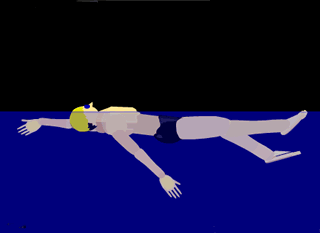Backstroke
The backstroke is a swimming technique that is performed in the supine position. In swimming there are no other conditions for performing this technique, except for performing in the supine position and performing the turn.
development
Historically, the sequence of movements has changed from the execution with simultaneous arm pull and chest-leg kick (known as " Old German back ") to an alternating arm pull with alternate leg kick (similar to crawl swimming, also known as "back crawl"). The more even feed enables higher speeds. The back crawl is now used consistently in competitive sports, the old German variant only in a few cases in master swimming and as an active recovery exercise in training. Other backstroke variants are used in lifeguarding .
Movement description "back crawl"
In the backstroke, the arm stroke is performed alternately, with the arms immersed in the water above the head, guided underwater towards the body in the direction of the legs and back above the surface of the water. In order to achieve the highest possible efficiency, the arm is not straight but bent underwater, as you have more strength in the bent arm (so-called forward elbow position). Alternatively, the alternating arm pull can also be replaced by gently moving the hands and forearms up and down. The upper arms are held stretched out on the side of the body. In both variants, the leg kick, as in crawl swimming , consists of alternating up and down movements of the legs from the hips. A strong kick in the backstroke stabilizes the position in the water.
Competition rules
The FINA competition rules state for this swimming technique that at the start signal and at every turn, you have to push off in the supine position and swim on your back during the entire competition. Except when turning, the body may not roll more than 90 degrees from its normal position; the position of the head is not decisive. Furthermore, part of the swimmer has to break through the water surface during the entire competition.
However, the swimmer is permitted to be completely submerged during the turn and for a distance of 15 meters after the start and after each turn. At this point the head must have broken through the surface of the water. When turning, the swimmer must touch the wall with any part of his body. During the turn, the shoulders may be turned over the vertical into the chest position. As soon as the body has left the supine position, continuous turning must be performed immediately. This means that the swimmer can either do a continuous arm pull or a so-called simultaneous double arm pull (both arms are pulled at the same time). Once the swimmer's arm stroke is complete, he must initiate the turn or hit the wall. The swimmer must have returned to the supine position when leaving the pool wall. Alternatively, a plate turn can be implemented.
When striking the target , the swimmer must lie on his back. However, the body no longer needs to be above water during the attack.
See also
Web links
- Competition regulations swimming (PDF file) of the German Swimming Association (DSV) as amended January 2016




